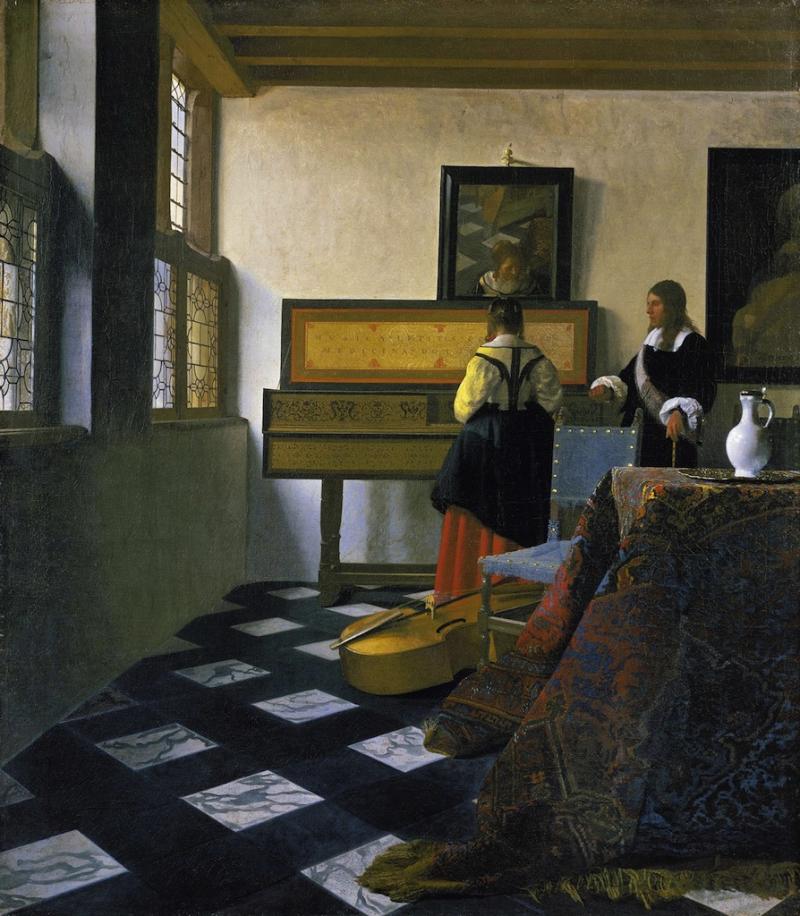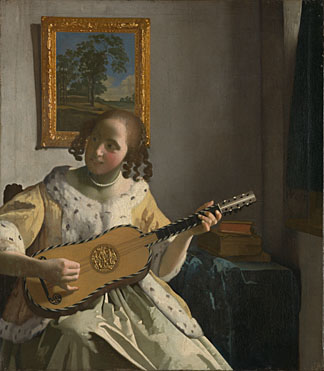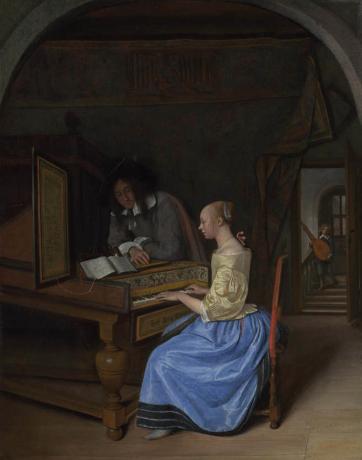Vermeer & Music: The Art of Love and Leisure, National Gallery | reviews, news & interviews
Vermeer & Music: The Art of Love and Leisure, National Gallery
Vermeer & Music: The Art of Love and Leisure, National Gallery
A glorious intertwining of two artforms during the Dutch Golden Age

Music and art have been intertwined for millennia, the static, frozen and soundless moment of paint capturing the feeling and the meaning of ephemeral time-based music. And nowhere can the act of making music have so thoroughly infiltrated a society at all levels than the Golden Age of Dutch culture in the 17th century.
Music is emblematic of time passing and its accompaniment, mortality
Music was part of the entertainment in brothels, bawdy houses, taverns, inns, part of the energetic goings-on of the working classes, and also profoundly integrated into the life and mores of the burgeoning middle-classes of this bubbling, innovative society. Artists supplied countless domestic-sized paintings for the newly wealthy. And it is estimated that a hefty percentage of all painting of the time across this spectrum of subjects also had music as a significant theme.
The meanings were various, and at times melancholy: music is emblematic of time passing and its accompaniment, mortality. But it could also mean celebration, enjoyment, and of course flirtation, courtship and love. This anthology of the period, mostly based on the National’s own collection, is an illuminating illustrated history lesson.
 For the Vermeers, A Young Woman standing at the Virginal and A Young Woman Sitting at the Virginal are from the home collection, The Music Lesson from the Royal Collection, The Guitar Player (pictured right) from Kenwood, and a tiny Young Woman Seated at a Virginal from a private collection in New York. As there are only about 34 (some disputed) surviving Vermeers in total, these five are a good helping: indeed nearly a quarter of his oeuvre has music as its ostensible subject.
For the Vermeers, A Young Woman standing at the Virginal and A Young Woman Sitting at the Virginal are from the home collection, The Music Lesson from the Royal Collection, The Guitar Player (pictured right) from Kenwood, and a tiny Young Woman Seated at a Virginal from a private collection in New York. As there are only about 34 (some disputed) surviving Vermeers in total, these five are a good helping: indeed nearly a quarter of his oeuvre has music as its ostensible subject.
The masterpiece is The Music Lesson (main picture), its ambiguity underlining the exhibition’s theme. The beautifully decorated virginal has its motto inscribed in Latin: “Music is the companion of joy, the medicine of sorrow”. The graceful young woman standing at the virginal, her back to us, has her serene face reflected in the mirror above; by the side of the instrument a formally dressed man in profile may be singing to her accompaniment. On the richly tiled floor a viol da gamba rests, its curved body’s resemblance to a female torso adding to the rich harvest of allusions. An Oriental rug acts as a table cloth, alluding, of course, to the riches brought home by the Dutch East India Company, and on the table top there is a gold salver bearing a demure white jug. The outstanding instrument itself would have been expensive, its quality evident. We are in a grand if domestic interior.
Is the woman a music student, a muse or a lover, or even a wife? Is the man a teacher, a visitor, a relative? Is it a meditation on Orsini’s remark in Twelfth Night, “If music be the food of love, play on”? We don’t know, but we can imagine, we can speculate, while we absorb the intricacy of decoration, of textile and instrument, the glorious orange and yellow of our lady’s dress.
The newly cleaned and resplendent The Guitar Player glitters with gold; the gilded frame of the landscape painting hanging on the wall, a gold lattice on the instrument itself; the pale yellow of the lady’s fur-trimmed overdress, the lemon yellow of her skirt. She cradles the baby-sized guitar almost as though it is a baby.
 Performances in a variety of groupings are explored. In Jan Steen’s A Young Woman Playing a Harpsichord to a Young Man (pictured left, © National Gallery) the harpsichord is inscribed with two mottos: “solely to the glory of God” and “actions prove the man” – the second undermining the piety of the first. In the background, a young man is coming down the stairs into the room carrying a theorbo, perhaps for the potential lover to make a musical duet as a prelude to a further amatory dance.
Performances in a variety of groupings are explored. In Jan Steen’s A Young Woman Playing a Harpsichord to a Young Man (pictured left, © National Gallery) the harpsichord is inscribed with two mottos: “solely to the glory of God” and “actions prove the man” – the second undermining the piety of the first. In the background, a young man is coming down the stairs into the room carrying a theorbo, perhaps for the potential lover to make a musical duet as a prelude to a further amatory dance.
Gabriel Metsu’s A Man and a Woman seated by a Virginal shows a young woman turning away from the keyboard and holding out a piece of music to the young man at her side, who in his turn is gesturing towards her with a flute of wine, in a toast of some kind. Meanwhile, Gerard ter Borch’s A Woman playing a Lute to Two Men shows two behatted men, one perhaps orchestrating the lady player who is reading a piece of music. There are the same props: the rug, the table, the pictures on the wall, the lady’s fur-trimmed house jacket, in its characteristic pale yellow, but here amplified by the pet dog coming into the room, his gaze curious. There is an upturned card on the floor, the ace of spades, and an orange has rolled under the lady’s skirt. A love triangle? Speculation adds to interest.
The paintings are amplified by vitrines containing beautifully crafted period musical instruments: virginal, violin, viol, guitar, lute, cittern, and 17th-century printed songbooks. From Thursday to Saturday throughout the show, the Academy of Ancient Music will play the real thing on the hour every hour.
- Vermeer & Music: The Art of Love and Leisure at the National Gallery until 8 September
Explore topics
Share this article
The future of Arts Journalism
You can stop theartsdesk.com closing!
We urgently need financing to survive. Our fundraising drive has thus far raised £33,000 but we need to reach £100,000 or we will be forced to close. Please contribute here: https://gofund.me/c3f6033d
And if you can forward this information to anyone who might assist, we’d be grateful.

Subscribe to theartsdesk.com
Thank you for continuing to read our work on theartsdesk.com. For unlimited access to every article in its entirety, including our archive of more than 15,000 pieces, we're asking for £5 per month or £40 per year. We feel it's a very good deal, and hope you do too.
To take a subscription now simply click here.
And if you're looking for that extra gift for a friend or family member, why not treat them to a theartsdesk.com gift subscription?
more Visual arts
 Help to give theartsdesk a future!
Support our GoFundMe appeal
Help to give theartsdesk a future!
Support our GoFundMe appeal
 Ed Atkins, Tate Britain review - hiding behind computer generated doppelgängers
Emotions too raw to explore
Ed Atkins, Tate Britain review - hiding behind computer generated doppelgängers
Emotions too raw to explore
 Echoes: Stone Circles, Community and Heritage, Stonehenge Visitor Centre review - young photographers explore ancient resonances
The ancient monument opens its first exhibition of new photography
Echoes: Stone Circles, Community and Heritage, Stonehenge Visitor Centre review - young photographers explore ancient resonances
The ancient monument opens its first exhibition of new photography
 Hylozoic/Desires: Salt Cosmologies, Somerset House and The Hedge of Halomancy, Tate Britain review - the power of white powder
A strong message diluted by space and time
Hylozoic/Desires: Salt Cosmologies, Somerset House and The Hedge of Halomancy, Tate Britain review - the power of white powder
A strong message diluted by space and time
 Mickalene Thomas, All About Love, Hayward Gallery review - all that glitters
The shock of the glue: rhinestones to the ready
Mickalene Thomas, All About Love, Hayward Gallery review - all that glitters
The shock of the glue: rhinestones to the ready
 Interview: Polar photographer Sebastian Copeland talks about the dramatic changes in the Arctic
An ominous shift has come with dark patches appearing on the Greenland ice sheet
Interview: Polar photographer Sebastian Copeland talks about the dramatic changes in the Arctic
An ominous shift has come with dark patches appearing on the Greenland ice sheet
 Donald Rodney: Visceral Canker, Whitechapel Gallery review - absence made powerfully present
Illness as a drive to creativity
Donald Rodney: Visceral Canker, Whitechapel Gallery review - absence made powerfully present
Illness as a drive to creativity
 Noah Davis, Barbican review - the ordinary made strangely compelling
A voice from the margins
Noah Davis, Barbican review - the ordinary made strangely compelling
A voice from the margins
 Best of 2024: Visual Arts
A great year for women artists
Best of 2024: Visual Arts
A great year for women artists
 Electric Dreams: Art and Technology Before the Internet, Tate Modern review - an exhaustive and exhausting show
Flashing lights, beeps and buzzes are diverting, but quickly pall
Electric Dreams: Art and Technology Before the Internet, Tate Modern review - an exhaustive and exhausting show
Flashing lights, beeps and buzzes are diverting, but quickly pall
 ARK: United States V by Laurie Anderson, Aviva Studios, Manchester review - a vessel for the thoughts and imaginings of a lifetime
Despite anticipating disaster, this mesmerising voyage is full of hope
ARK: United States V by Laurie Anderson, Aviva Studios, Manchester review - a vessel for the thoughts and imaginings of a lifetime
Despite anticipating disaster, this mesmerising voyage is full of hope

Add comment